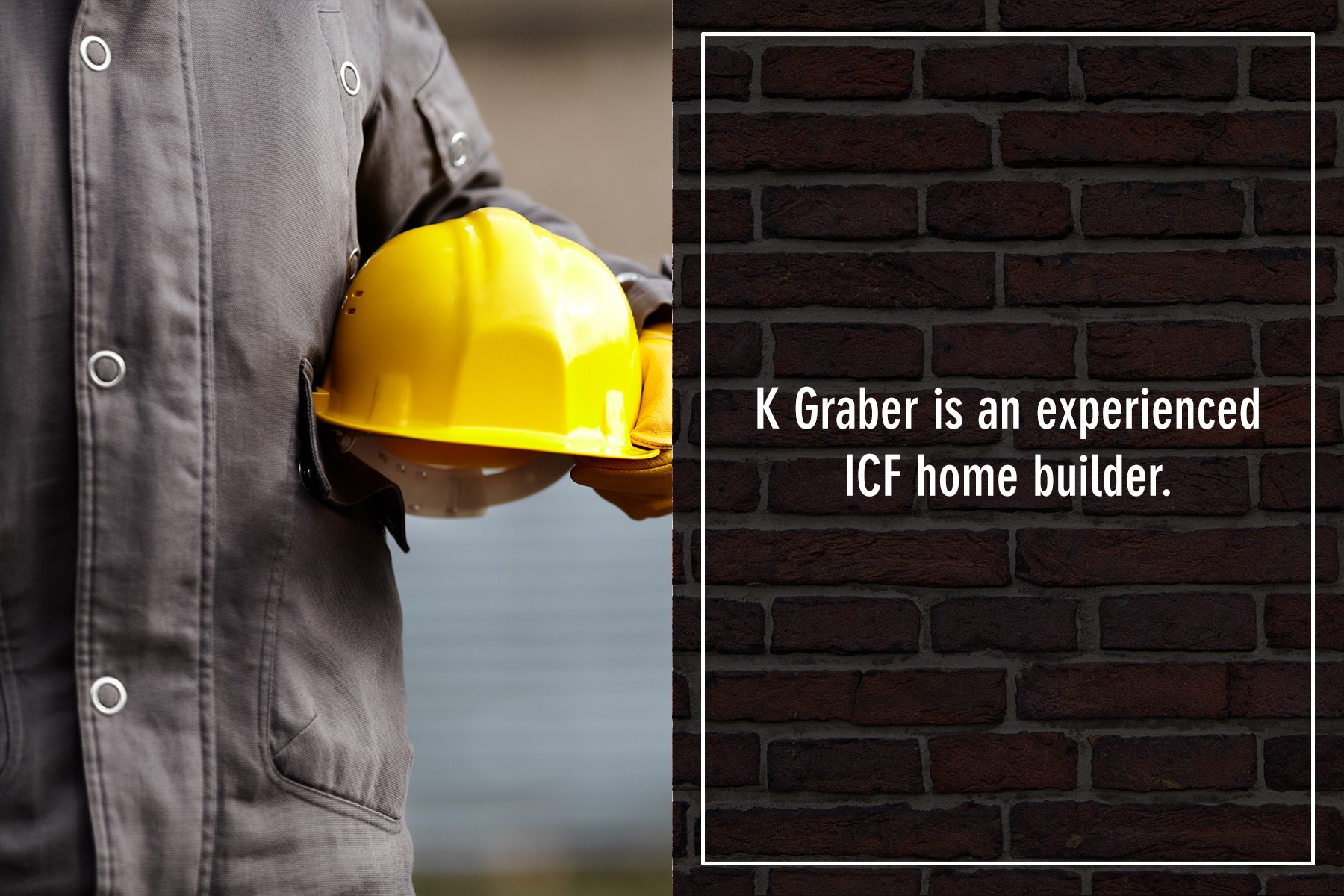
ICF Construction: What It Is, How It Works, and 6 Reasons You Need It
Your phone blares with a severe weather alert. Your heart starts beating harder, and your hands get sweaty. Is it a tornado? A really bad thunderstorm? Does your home have what it takes to survive a severe weather event?
We get it. Everyone wants to feel safe in their own home, but sometimes our houses feel pretty wimpy when compared with Mother Nature.
Today we want to help you learn about ICF Construction—a way of building your home that makes it nearly indestructible.
At K Graber, we’ve seen how ICF-constructed homes stand tall when others crumble.
Are you ready to roll over and go right back to sleep when a storm alert comes through in the middle of the night, confident that your home is strong and secure?
Let’s get started!
What Is ICF Construction?
Let's start by going through the ICF construction basics.
After all, what even is ICF construction? If you've never heard the term, you're not alone!
ICF Construction Summarized
ICF is an acronym for Insulated Concrete Forms.
The basic building blocks of ICF construction are sections of rigid insulating material separated by plastic webbing. These blocks are simply stacked together like legos to create a hollow form. Then, concrete is poured into the form.
When you're finished, you have a solid concrete wall continuously insulated on both the inside and outside!
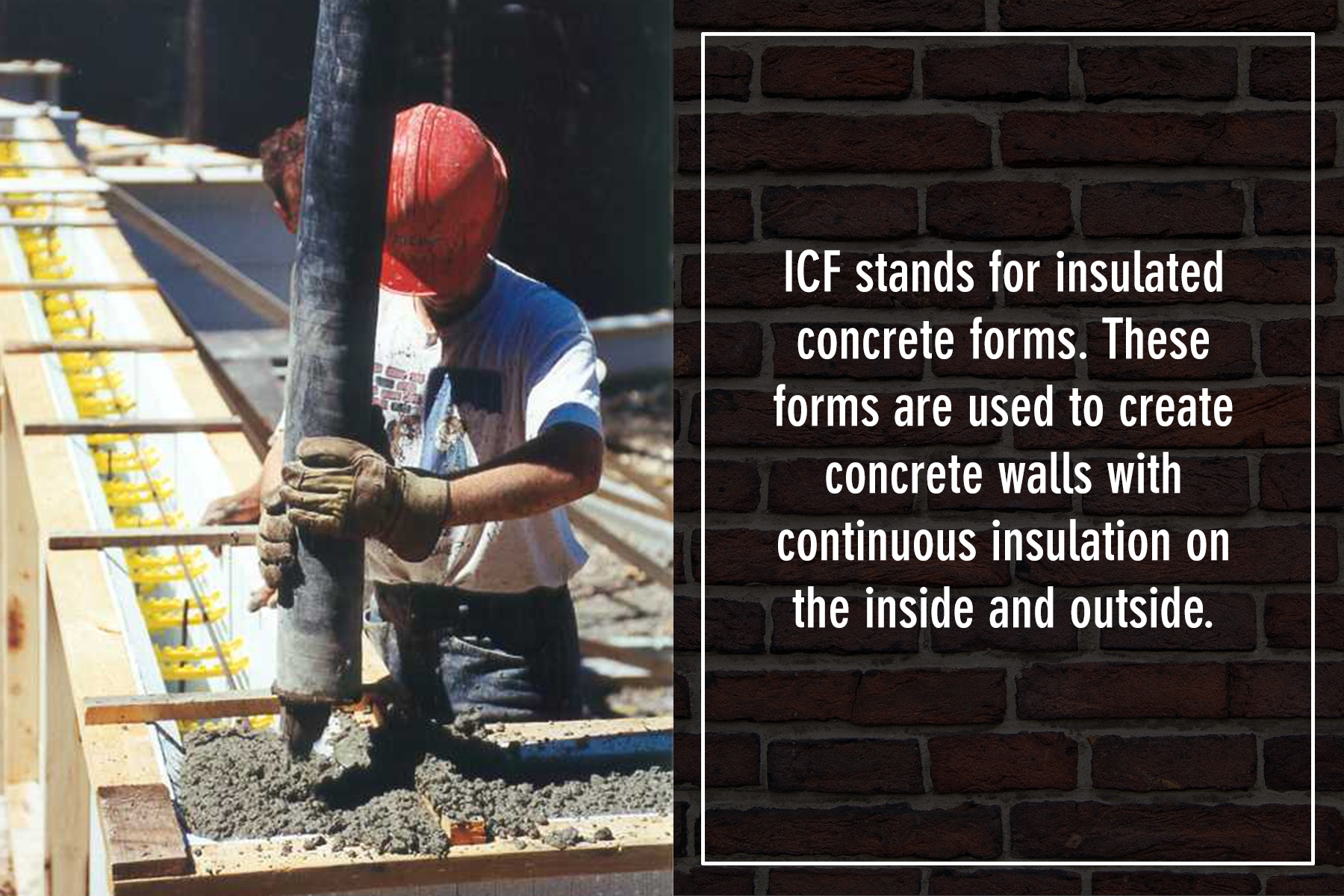
History Of ICF Construction
Filling foam blocks with cement to build houses is a pretty innovative idea.
So how did it even start?
The first known ICFs were Durisol insulated concrete forms, which were developed in Belgium in 1937. It was quick, cost-effective, and durable, and quickly became popular.
However, Durisol forms were made from cement-bonded wood fiber products. Foam forms weren't used until a Canadian contractor, Werner Gregori, came up with the idea.
This is how he tells the story:
“In the summer of 1965, I was vacationing up north at Algonquian Park. We had one of those foam plastic coolers to keep the drink cold. When I saw kids on the beach playing with the sand, I realized that if concrete blocks could be formed using that foam plastic, many construction costs and hours of labor could be eliminated.”
Within a year he had converted his foam cooler epiphany into the first ICF.
Called “Foam Form” each block measured 16 inches high by 48 inches long with a tongue-and-groove interlock, metal ties, and a waffle-grid core.
The patent was officially submitted in Canada on March 22, 1966, and the U.S. patent application was granted on October 24, 1968.
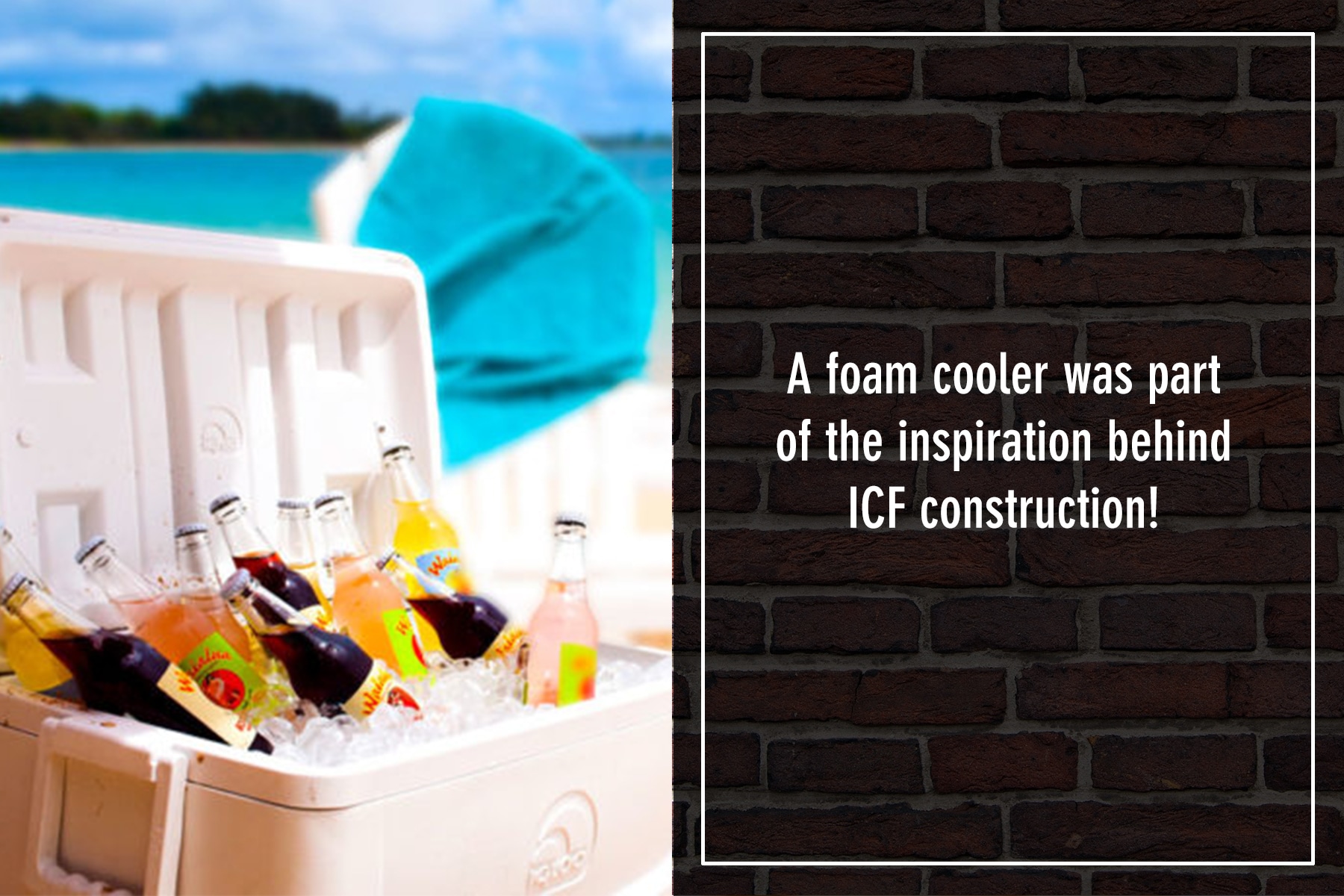
How Does ICF Construction Work?
We’ve taken a brief look at what ICF construction is, and we know the basic materials that are used in ICF construction.
But what if you want to build a house using ICFs? Or perhaps you are a contractor wanting to add another tool to your skill set.
Let’s get into how ICF construction actually works!
Preparatory Work For ICF Walls
Like any type of construction, you must do some preparatory work before you begin assembling ICF walls.
Step 1: Pour the footer
ICF walls require a concrete footer, just like block walls do. Pouring a concrete footer is a process in and of itself—but it’s not our purpose to explore in this article.
The most important things are to make sure that the footer is level to within a ¼ inch and to reinforce the footer according to the engineer's instructions.
Also, make sure to place vertical rebar in the footer that extends beyond the top of the footing by at least 20-25 inches. You may need more depending on the lap requirements, as well as seismic and wind load ratings.
Assembling ICF Walls
Once your concrete footer is ready, it’s time to start building the walls.
Step 2: Stack the ICF form blocks
At first, it may seem like ICF construction is a matter of sticking a few blocks together, but assembling these walls is not child’s play!
We highly recommend hiring an ICF expert since different types of ICF building blocks require various methods of assembly. If you can’t hire a contractor, make sure you are in very close communication with the block manufacturer, so you can be confident you're assembling them correctly!
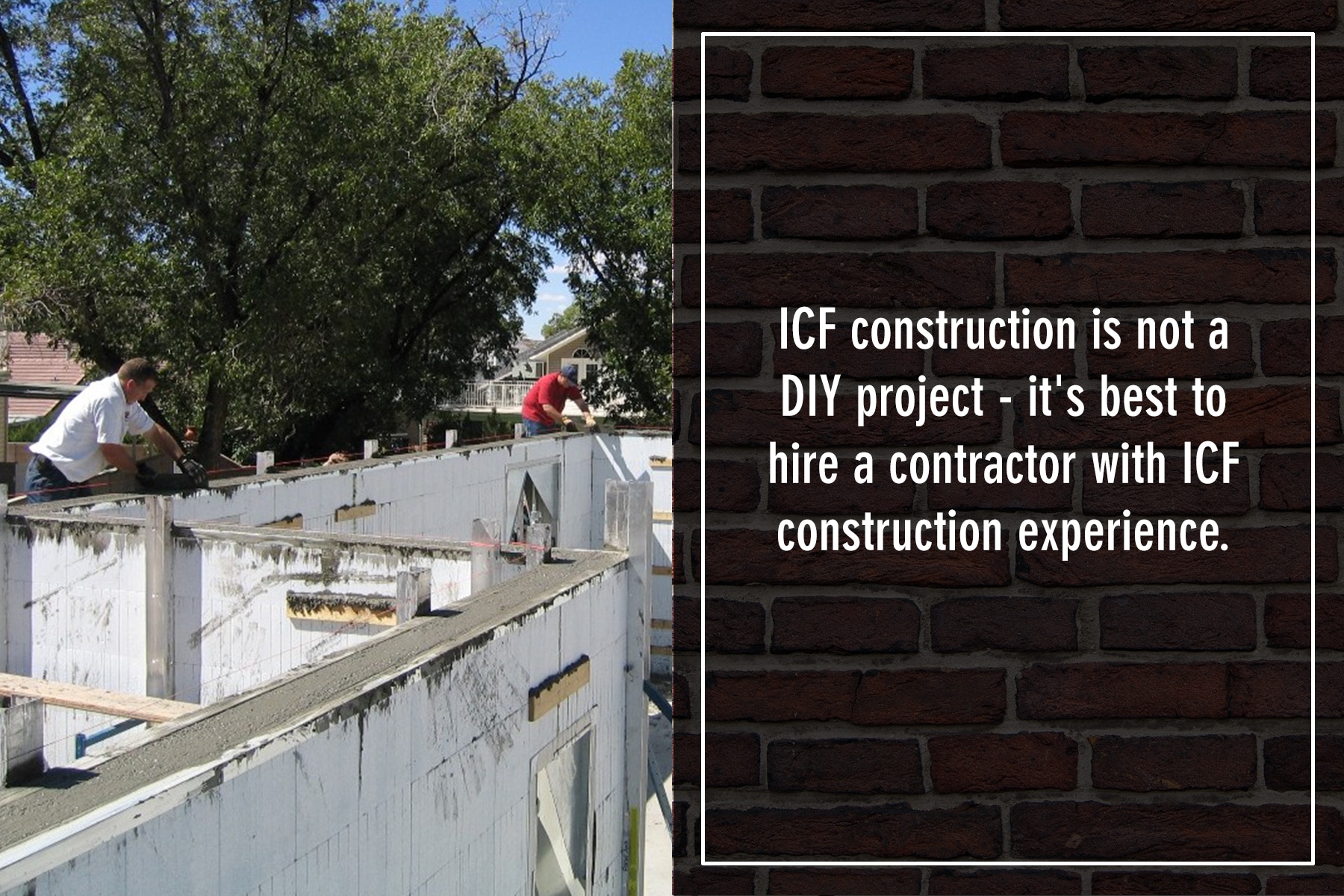
It's important to follow instructions to the letter, from the spacing of plastic reinforcing webs to how you stack the blocks.
Any minor mistake can cost you a lot of time and money.
However, here are a few critical components to ensure you don't miss when constructing ICF walls.
- Place horizontal rebar on the internal webs within the block cavity with each new row of blocks. Rebar must be continuous, and where the rebar splices, make sure to lap and tie.
- Use a transit level to check that the wall is level. If the wall is not level, place shims or trim the blocks as required.
- Install the internal webbing as required on each block. Pay particular attention to the manufacturer's instructions at corners or anywhere one wall meets another.
- Install window and door bucks where you will be placing windows and doors
- Cut any holes in the foam where electrical or plumbing lines will run through the wall. Then place a PVC pipe large enough for the line through the wall.
- After the wall is completely stacked, place your vertical rebar.
Step 3: Install vertical alignment bracing around the entire structure
The bracing keeps the walls straight and plumb. The bracing also allows for alignment adjustment before and during the concrete pour.
In addition, the bracing serves the additional purpose of providing a secure and safe framework to support scaffolding planks.
Pouring Concrete In ICF Walls
Once your ICF walls are constructed and properly braced, it's time to fill them with concrete!
Step 4: Place the concrete into the walls
In this case, you will want to make sure to have a boom or line pump to fill the concrete walls.
We recommend placing the concrete in lifts about four feet at a time. All you have to do is repeat this process until you reach the top of the wall.
Again, having an experienced concrete contractor to complete this step is a must. If the concrete isn't placed and consolidated correctly, the wall's integrity may be compromised.
And you don't want that!
In a worst-case scenario, you may have a blowout that results in significant delays, wastes money, and may even cause serious injury.
(Not sure how to find a trustworthy contractor near you? Check out our blog on hiring a good concrete contractor.)
Step 5: Use a mechanical vibrator to remove air pockets from the concrete
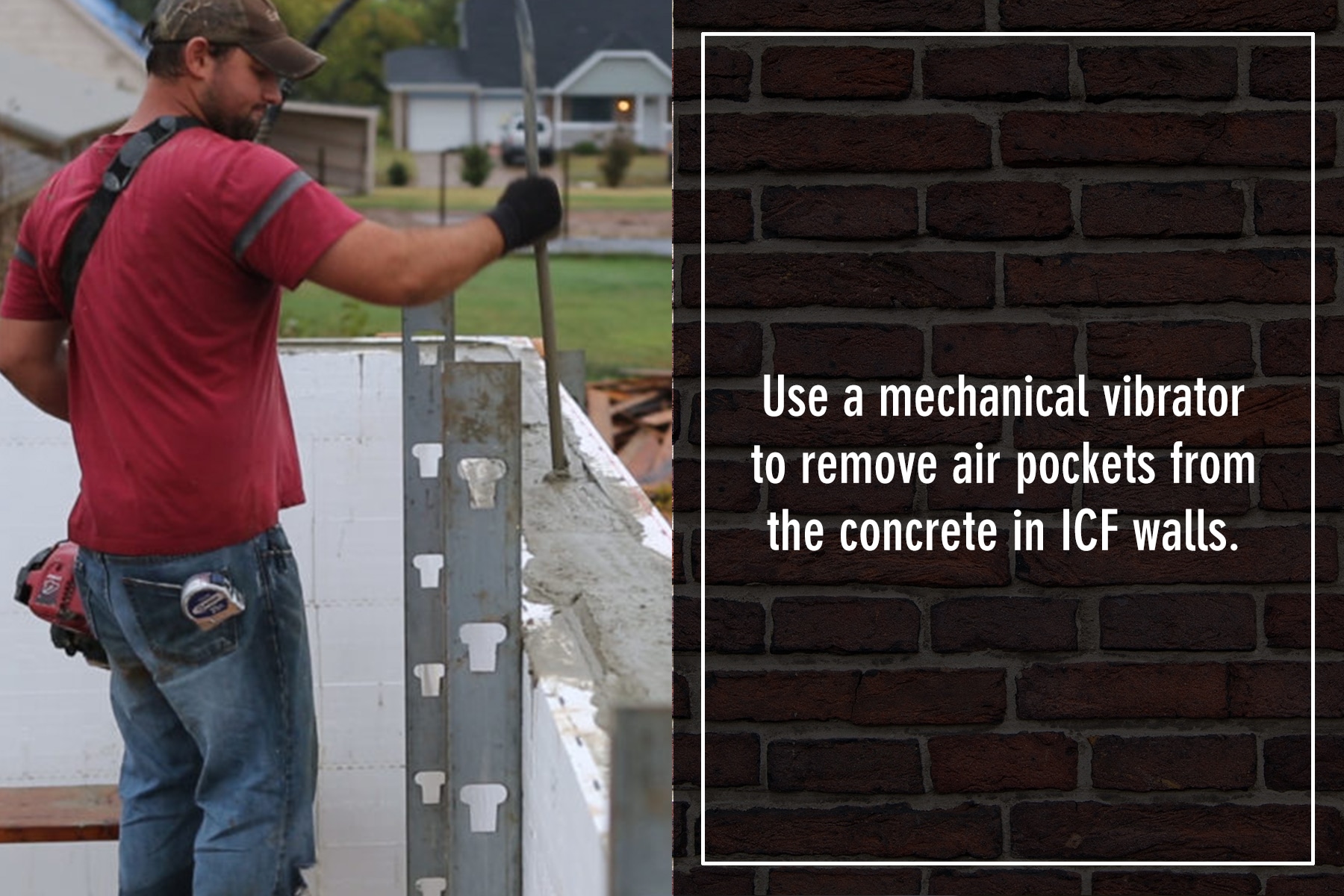
Step 6: Finish the concrete
Level off the concrete until it is even with the block top, and then wet set anchor bolts into the concrete block top. The anchor bolts are used later to install the top plate and mud sill for the installation of rafters or trusses.
Finishing ICF Walls
If you’ve built the ICF walls correctly, and if the concrete was poured properly, you should now have a building as strong as a fortress!
However, there are a few steps that must happen in order to ensure the longevity of your ICF walls.
Step 7: Waterproof your ICF Walls
Building codes require habitable interior enclosed spaces to be waterproofed.
Thankfully, there are many waterproofing systems to choose from. Many of these systems are widely used and very effective.
Here are a few options you could try:
- Spray-on membranes for ICF walls (CAUTION: do not use petroleum-based paint or primer. These products will dissolve the EPS foam.)
- A self-adhesive membrane for ICF walls like PolyWall Home Stretch
- Mat-type protection for ICF walls like SuperSeal or DMX-AG.
We recommend consulting a local ICF contractor to see what kind of sealant works best in your geographical area.
Step 8: Choose and install your choice of wall finish
No one wants the wall of their home to look like they're made from foam—even if they are!
That's why you want to use a wall finish on your ICF construction home.
Once your walls are finally constructed you can choose to finish them with almost any product, including:
- Masonry veneers
- Stucco
- Panel siding
- Vinyl or wood siding
- Fiber cement boards
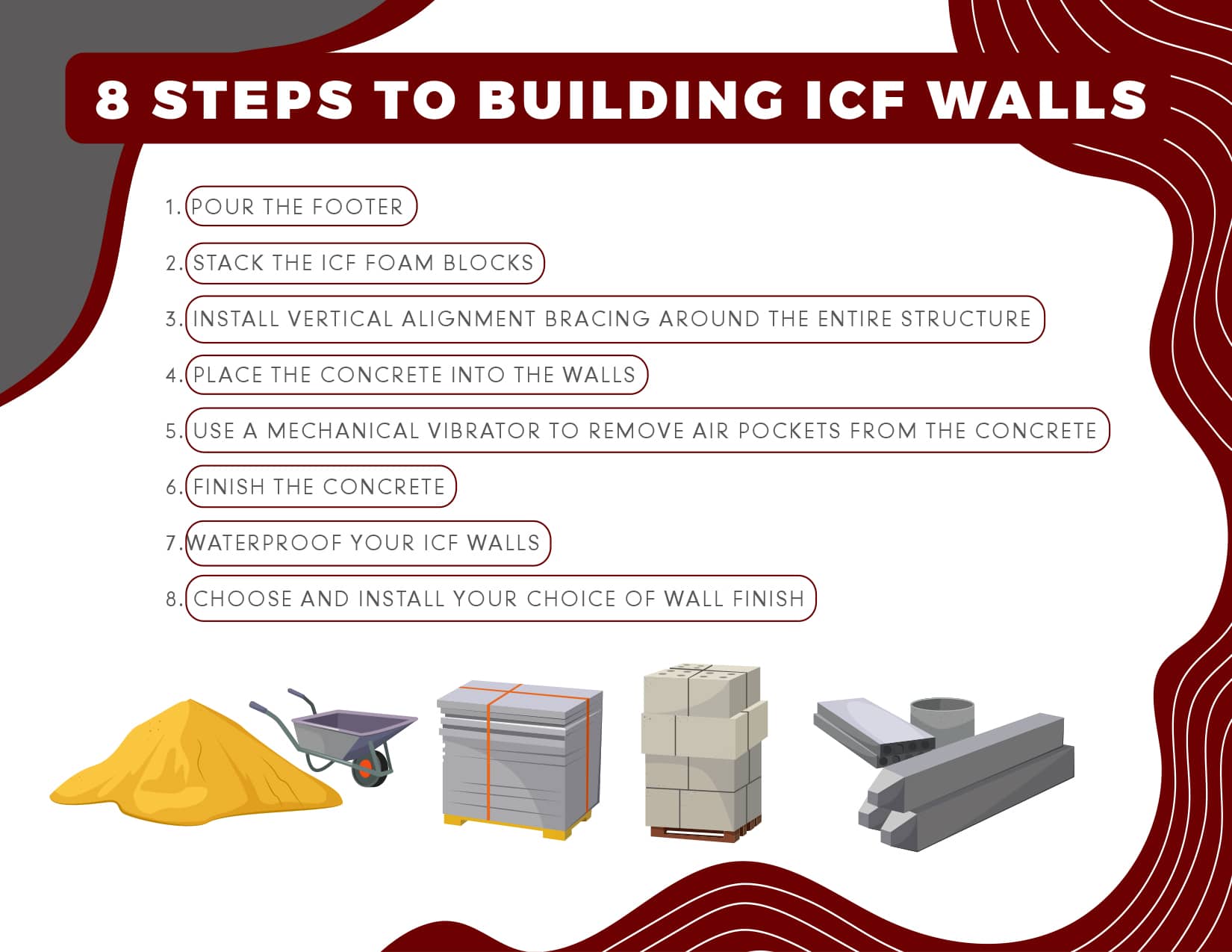
ICF Walls And Block Styles
All ICF walls and blocks are similar in their fundamental design. However, there are a few different styles to choose from.
Let’s take a look at each style so you can choose which is best for you.
ICF Wall Styles
There are three primary kinds of ICF walls.
- Flat wall
- Waffle-grid
- Screen- grid
With Flat wall systems, your wall will maintain a continuous thickness of concrete, like a conventional poured wall.
Waffle grid systems have a waffle pattern, making the concrete thicker at some points than others.
And finally, screen grid systems have widely spaced horizontal and vertical columns of concrete, which are completely encapsulated in foam.
Flat wall systems are the strongest of these three systems, and we highly recommend them. At a minimum, make sure to use the flat wall system below grade.
If you live in an area that does not experience severe weather like tornadoes or hurricanes, you could consider a waffle-grid or screen-grid system when you're building above grade.
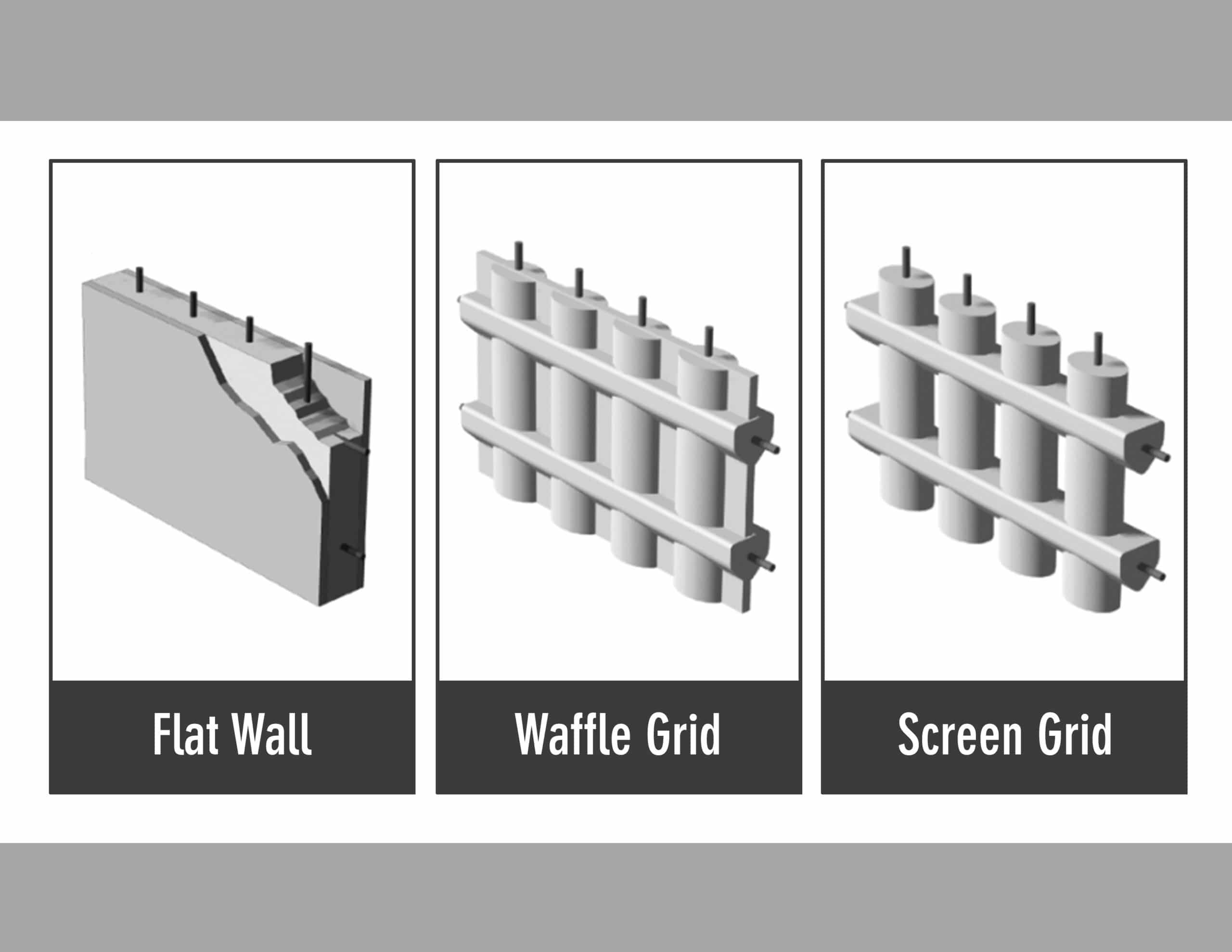
Types Of ICF Blocks
There are over 20 brands of ICFs in North America, and each manufacturer makes its blocks a little differently.
However, there are a few common denominators between all ICF blocks.
First of all, all ICF blocks have some method of interlocking.
Some forms feature interlocking teeth, while others offer a tongue and groove configuration. Many manufacturers have developed blocks with universal interlocks that allow the forms to stack whether the block is flipped one way or another.
All ICF blocks also come with some kind of reinforcing tie or webbing that holds the foam exterior together and allows you to pour concrete into the hollow core.
The ties that interconnect the two layers of insulated forming material can be plastic, metal, or additional projections of the insulation.
You can also choose to have the interconnecting ties preinstalled, or install them yourself.
If the ties are not preinstalled, the ICF blocks will ship as foam panels or planks that you can assemble into forms on the job. This means your blocks ship more compactly, but requires more work on the job.
A typical ICF block is usually 16 inches high by 48 inches long. The cavities are commonly 6-8 inches wide but can be larger or smaller as needed.
The foam faces can also vary, but the usual range is 1 ⅞ - 2 ¾ inch thickness. More recently, some systems offer thicker layers of foam to enhance performance.
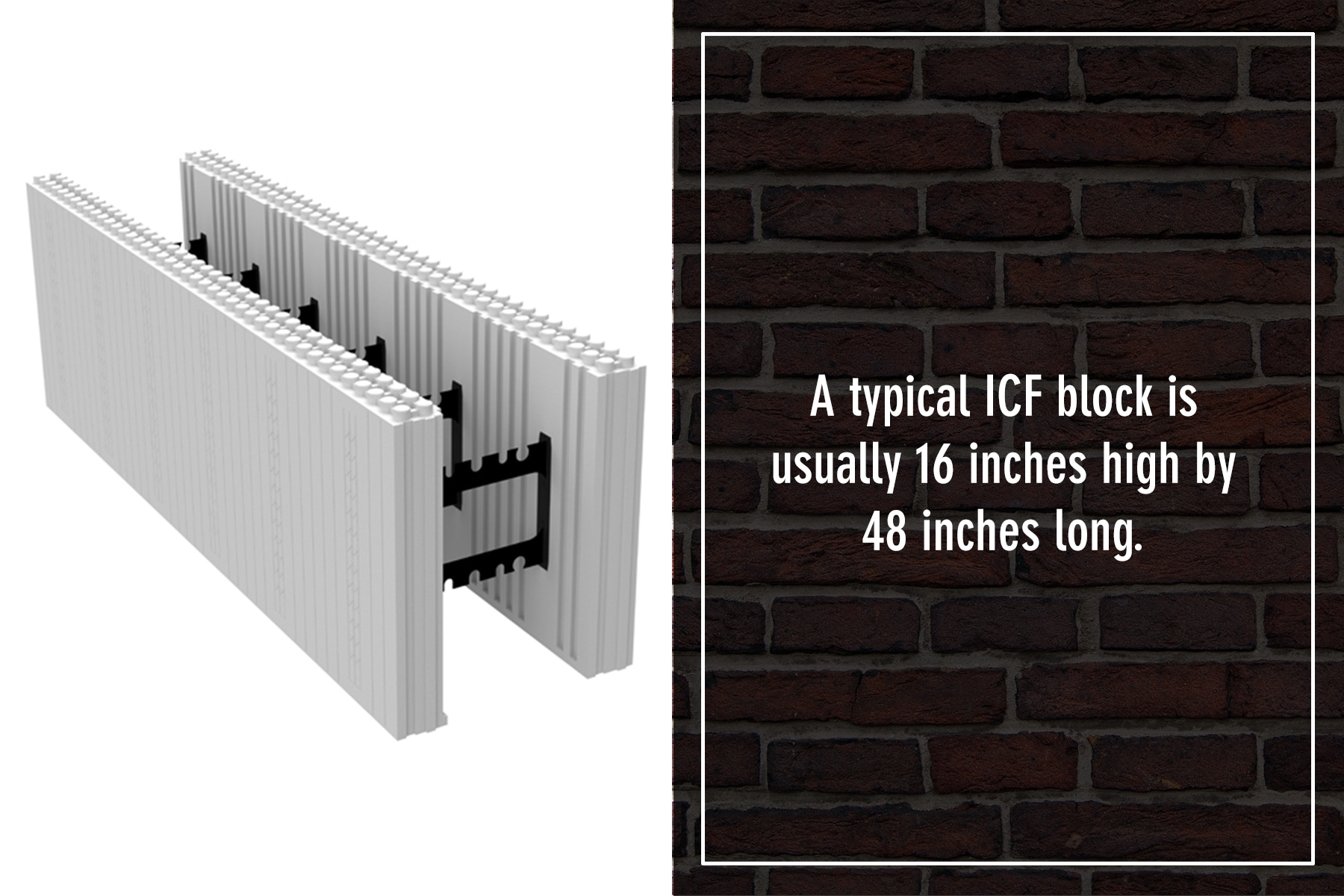
6 Pros Of ICF Construction
If you are a homeowner trying to decide whether or not to use ICF construction, the details of assembly and different types of blocks may not matter too much compared to your main question:
Is ICF construction the best investment in your new home?
Let’s take a look at the pros and cons of ICF construction so you can find out for yourself.
Energy Savings And Reduced Environmental Impact
One of the big advantages of ICFs for homeowners is energy efficiency. A recent groundbreaking study found that ICF walls had 60% less energy loss than traditional homes.
There are several reasons ICF homes are so energy efficient:
- The foam panels in ICFs prove an R-value of R-25 and above. While this number is not shockingly high, the fact that there are zero breaks in the insulation makes it very efficient (each stud in a traditionally framed house is a break-in insulation). In the end, ICF homes have a higher R-value than traditionally framed homes.
- The thermal mass of the concrete core in the wall also greatly reduces heat loss
- The continuous foam and concrete create an airtight building envelope
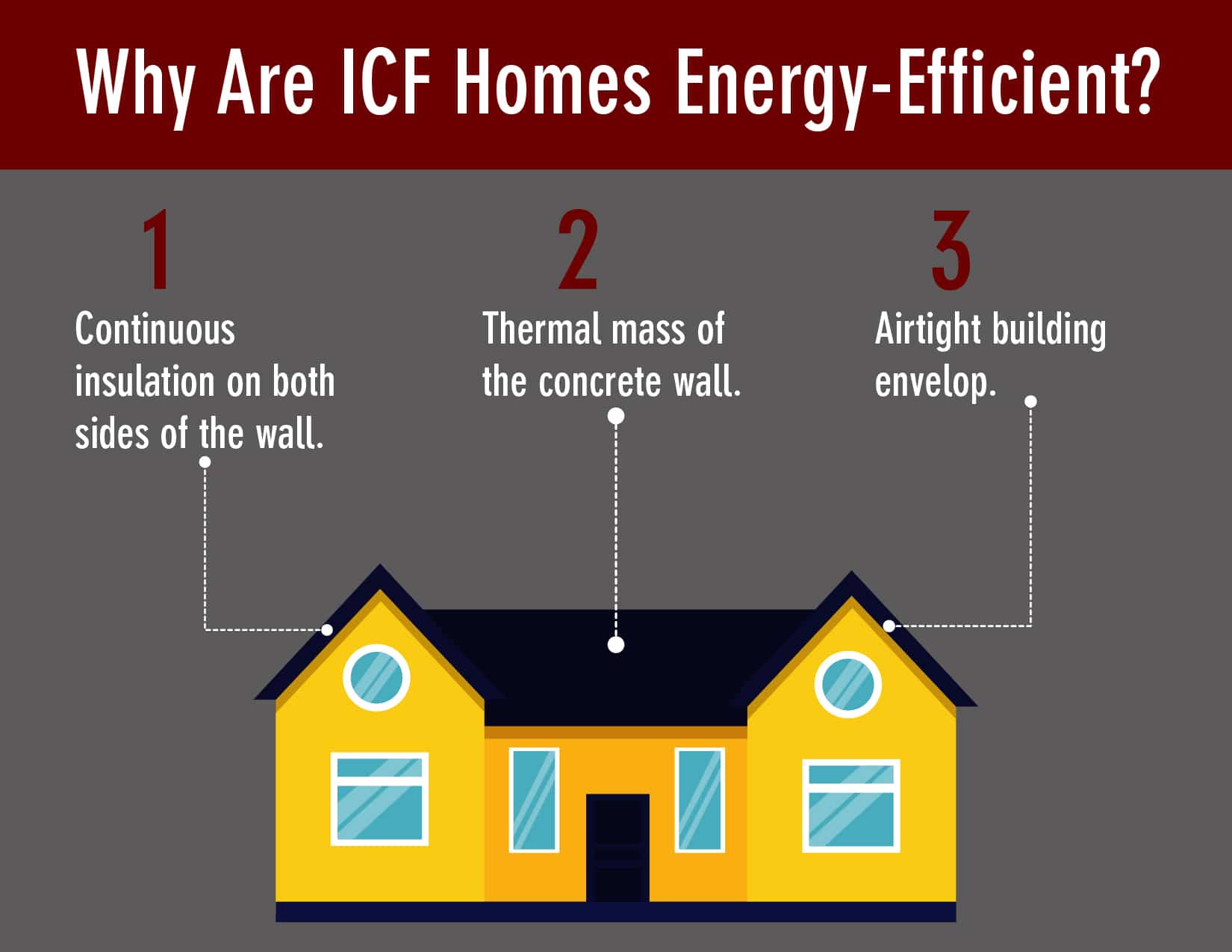
Better insulation doesn’t just cut down on energy savings, it also allows you to save money on things like your HVAC system. Not only can you get by with a smaller system, but by not overworking your heating and cooling systems, they will last much longer.
Interested in other types of energy-efficient construction? Read our blog on pole barn homes.
Structural Integrity
Compared to other materials like wood, ICF blocks are extremely durable. They’re resistant to rot, mold, moisture, insect infestation, and other elements that could compromise the integrity of your building.
They also stand up very well to harsh weather conditions like high winds and seismic activity.
Here’s just one example of how an ICF home stood up against Hurricane Michael while the surrounding homes were destroyed.
But, this shouldn’t really surprise us. After all, we’re talking about 6 or more inches of solid, reinforced concrete here!
For this reason, many extreme weather shelters and buildings in dangerous weather areas are now being built with ICF blocks. ICF homes and buildings have an excellent track record of providing safety in these conditions.
In fact, it’s not uncommon for homeowners to receive lower insurance premiums after building an ICF basement or other project because insurance companies recognize the data on how safe, efficient, and durable ICF construction is.
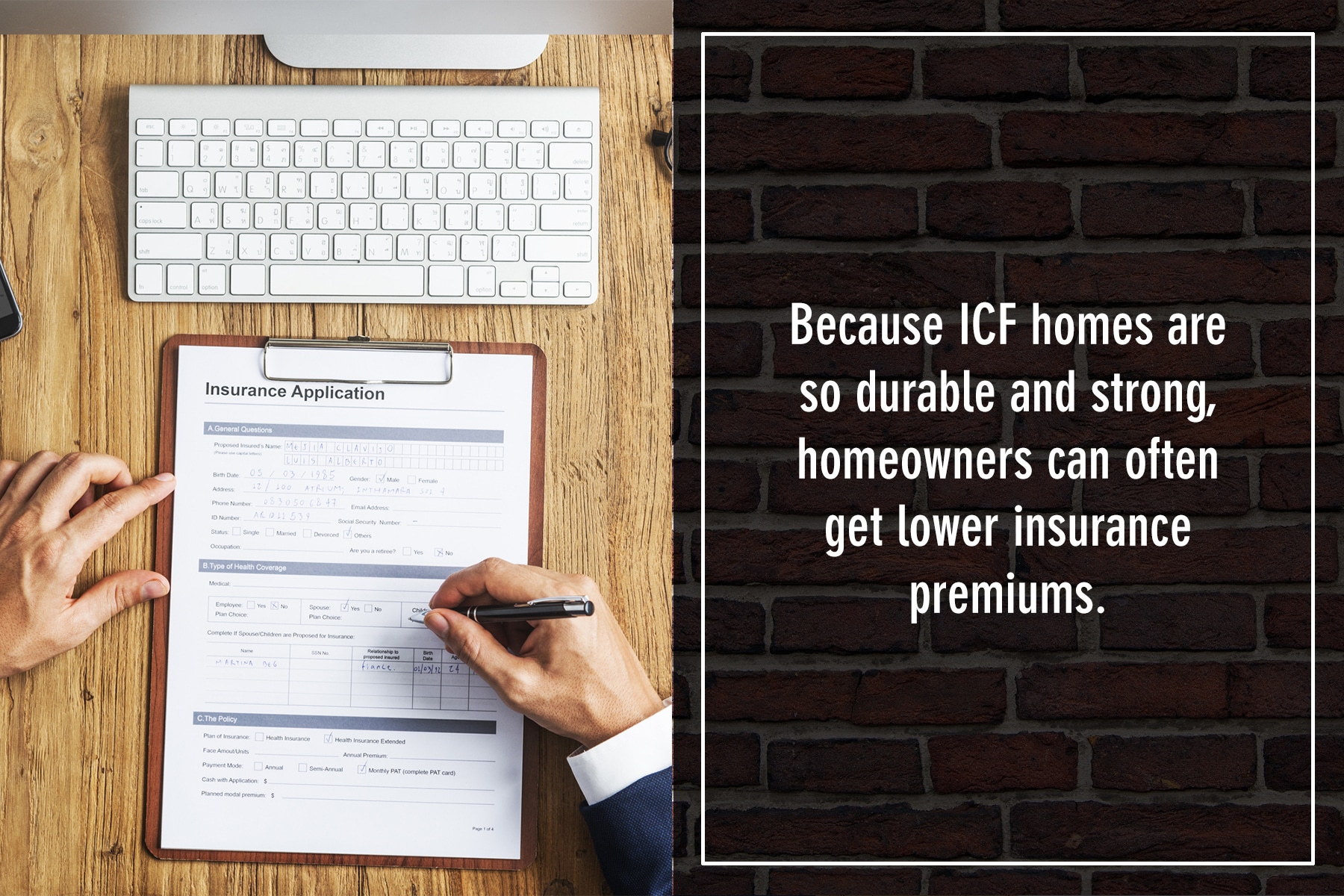
Cut Down On Noise
As an additional positive outcome to the outstanding thermal insulation, ICF also provides significant acoustic insulation between walls.
In fact, most ICF walls have a sound transmission class of 56 which is far greater than regular walls. A loud noise outside can be reduced to just a whisper inside an ICF home.
This makes ICF not only a good fit for residential projects where peace and quiet are a high priority, but also for commercial settings where soundproofing is essential to the core function of the building. For example, movie theaters are often constructed using ICF.
Therefore, not only does ICF often eliminate the need for traditional insulation material, but also prevents the necessity of installing acoustic insulation panels as well.
Fire Resistant
ICF walls are great at withstanding high winds and other natural disasters like earthquakes.
But how about fires?
As it turns out, ICF construction excels there too.
In a recent study, all the leading brands of ICF construction were able to withstand temperatures of up to 2,000 degrees Fahrenheit for as long as 4 hours. On the other hand, wood frame walls typically collapse within an hour or less.
Contrary to popular belief, the foam used in ICFs will not burn. It will melt if exposed to high heat, but it will not contribute any fuel to the fire. In fact, it is virtually “self-extinguishing,” thanks to a flame retardant all of the leading ICF manufacturers add to the EPS foam.
Sustained Comfort
Is anything more frustrating than constantly adjusting the thermostat? It’s simply annoying, and it gives us the nagging feeling that we’re wasting money we wouldn’t have to.
Thankfully, ICF walls keep your home at a consistent temperature, even when the AC or heat goes out.
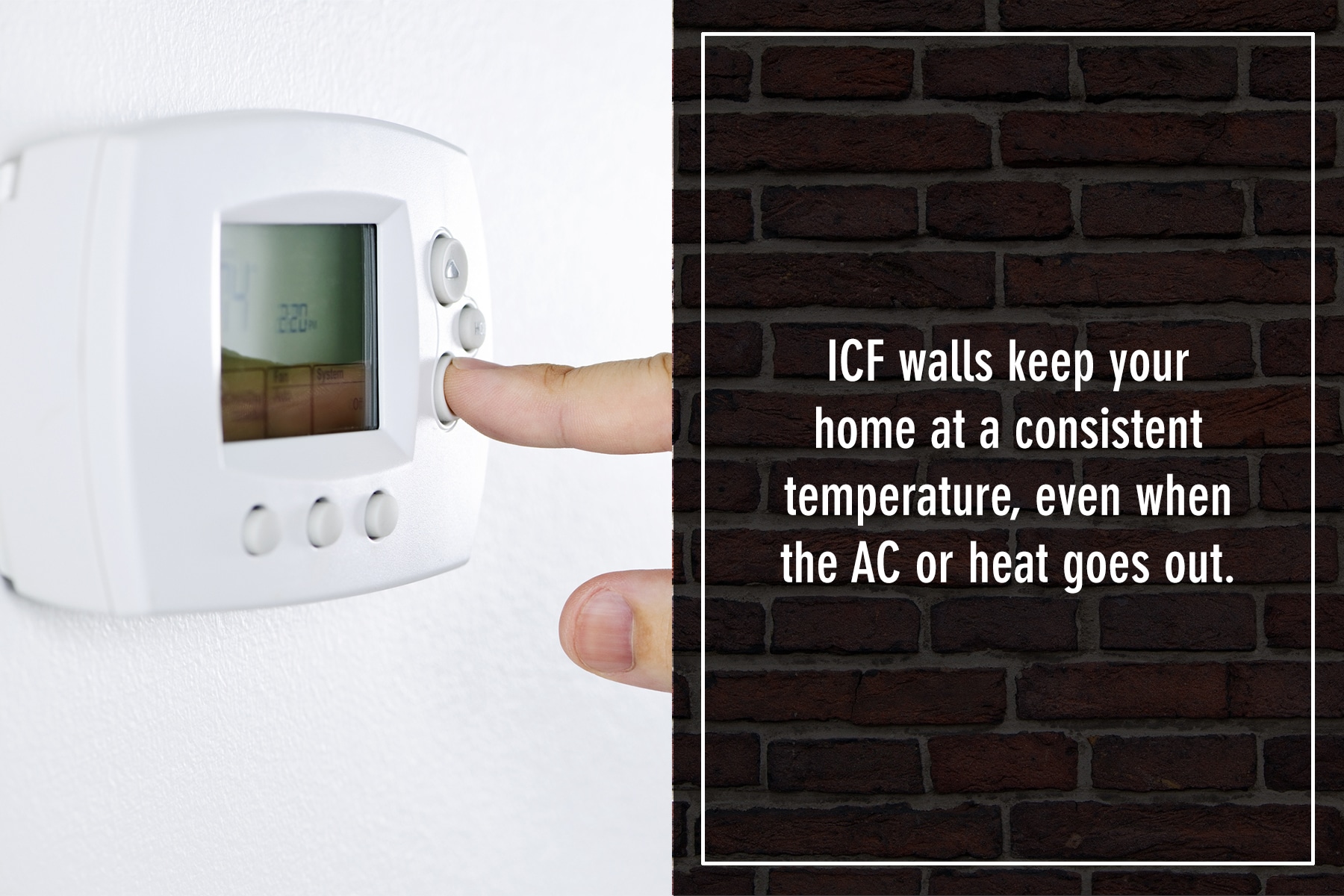
But let’s put some numbers to this.
How long does it take particular types of homes to reach equilibrium with outside temperatures after the power goes off?
- Wood 2x6 wall with R-20 insulation: 4.8 hours
- Steel 2x5 wall with R-20+5 insulation: 5.9 hours
- Wood 2x6 wall with R-24 insulation: 12.75 hours
- Wood 2x6 wall with R-20+5 insulation: 54 hours
- ICF walls: 144 hours
Improved Air Quality
Because an ICF wall consists of concrete that is surrounded entirely by foam, there is less overall air movement from the exterior of the structure to the indoor environment.
That means you will experience a 75% reduction in the levels of allergens and dust that are present inside.
Since you have better soundproofing with ICFs as well, you will feel like there is a genuine separation between what happens outside and the events that occur inside.
5 Cons Of ICF Construction
Every product has a few weaknesses, and ICF construction is no different than the rest. Let’s explore a few disadvantages of ICFs so you can compare the good with the bad.
Seams In The ICF Walls
It is not unusual for first-time contractors working with ICFs to think that the structure should fit together perfectly like a set of Legos.
However, the building process is closer to what you would experience when laying a deck or patio.
You’ll need to work from the corners of your design toward the middle and then cut a block to fit the final gap where your two lines meet up. This building process then creates a seam in the structure that requires expanding foam to help secure it.
And of course, this is just one of many seams in ICF walls.
If not properly sealed, these seams can leak and cause damage to your home.
ICF Construction Can Be Expensive
Like most things in life, you have to pay for high-quality items. ICF construction is no different.
ICF house construction typically costs between $100 and $250 per square foot. This is typically about $5 more per square foot than a lumber house, which has become more expensive as the cost of wood rises.
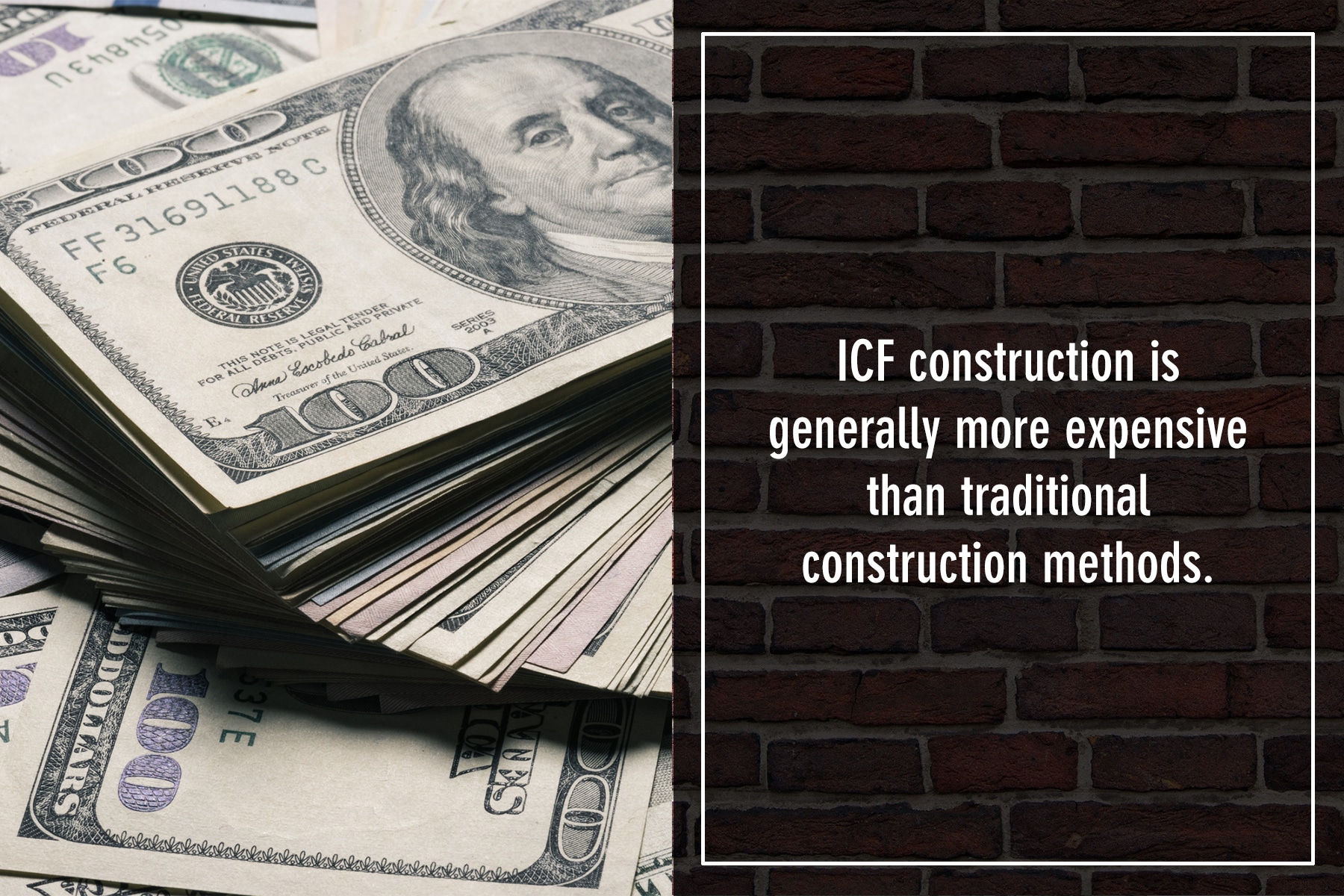
Of course, you should remember that ICF construction requires much less maintenance than wood framing, and a good portion of the extra costs for ICF construction may be recouped in maintenance and energy savings.
Plastic Studs Are Not As Strong
ICF walls are equipped with plastic studs, so you can put drywall, paneling, or other materials on your wall.
Plus, it’s important to have something on the walls where you can attach artwork, shelves, and other items.
ICF manufacturers claim that their plastic studs can hold as much as wooden studs, but while the studs are surprisingly strong, this claim is not always true.
Beyond that, the plastic studs tend to splinter if your nail or screw hits them near the edge. As a result, the width of the stud you have to work with is greatly diminished.
Difficult Remodeling
Concrete is great, but once it’s there, it’s difficult to move!
That means that any doors or windows you want to add in the future will be quite a task. Sometimes even small jobs like running new electrical wires can be challenging as well.
Less Floor Space
While the thick walls of ICF construction serve to make homeowners safe and secure, they do have one downside: less floor space.
Thankfully, the thick walls also have a neat benefit that many people don’t think of - deep windows!
Deep window sills are beautiful and give ample opportunities for decorating, window seats, creating bookshelves, or other creative ideas.
Conclusion
Do you want to feel secure and protected in your home?
ICF walls may be the answer.
Not only do ICF walls provide strength and durability, but they also cut down on a lot of maintenance work, and they are energy efficient.
Of course, this construction method comes with one major challenge: finding a good contractor who's skilled in ICF work!
But if you live in Northern Indiana, you are in luck. K Graber Construction is a general contractor in Northern Indiana and we’ve been building ICF homes for years!
Beyond that, we offer other services like:
And the best part? We make getting your job done super easy.
All you have to do is:
- Get a free quote. We’ll meet, assess your project, and talk about your goals.
- Approve the estimate and design
- Let us do all the work
- Enjoy your new space
Contact us today and get a quote. We look forward to hearing from you!
